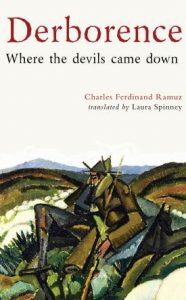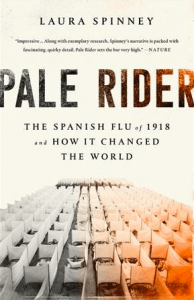Derborence: Where the devils came down
— my translation of Charles-Ferdinand Ramuz’s best-loved novel, published by Skomlin Press in 2018
A mountain falls down and an alpine village is frozen in its summer state. When a ghostly figure appears beyond the last house, the villagers are terrorised. Is it a soul trapped in limbo, come to make his baleful complaint? Only one of them recognises him as a survivor, her husband in flesh and blood. The village rejoices, but when the survivor declares his intention to return beneath the rubble, the old doubts resurface. Swiss writer Charles-Ferdinand Ramuz sets his masterful tale of love and loss against the tectonic indifference of the high Alps.
Pale Rider: The Spanish Flu of 1918 and How it Changed the World
— first published by Jonathan Cape in 2017
With a death toll of between 50 and 100 million people and a global reach, the Spanish flu of 1918–1920 was the greatest human disaster, not only of the twentieth century, but possibly in all of recorded history. And yet, in our popular conception it exists largely as a footnote to World War I. In Pale Rider, Laura Spinney recounts the story of an overlooked pandemic.
“Spinney is a storyteller with a science writer’s cabinet of facts…” Science
“Absorbing… Important… Magisterial…” The Observer
Rue Centrale: portrait of a European city
— first published by Editions L’Age d’Homme in 2013
Lausanne is a cosmopolitan city located at the heart of Europe. Viewing it as a microcosm of the continent as a whole, Laura Spinney goes out to meet its inhabitants. The result is a portrait of a European city painted in the words of the people who live and work there. Encountered in the street, in their bedroom, on a barge or in the belfry of the cathedral, 68 individuals talk about their hopes, their fears and their daily lives. Bankers, prostitutes, illegal immigrants, pillars of the community… word by word, from the grassroots up, they build a city in Europe at the beginning of the 21st century.
The Quick
— first published by Fourth Estate in 2007
For ten years, Patient DL has lain motionless in a small room at the end of a hospital corridor. She has suffered massive damage to her brain, and it’s not clear whether she can see or hear the world around her.
The young doctor who is charged with finding a spark in DL’s lifeless body discovers that none of the hospital staff who care for her can remember who she was or what she did, before the accident that brought her there. Three people can offer a clue, the people who still visit her. But each one remembers her differently.
What causes her family to behave in such eccentric and perplexing ways? And why does DL’s estranged husband visit her only in the dead of night? As the strange case becomes known to the outside world, the doctor who narrates the tale is caught up in the ethical dilemma at the heart of this brilliant and unsettling novel.
“Spinney’s novel belongs to those creative enterprises pursued by writers, playwrights, and other artists who have applied their varying practices in the exploration of how medicine… confronts the boldest and most unruly aspects of life.” The Lancet
“…a life-affirming vision of the powers of imagination” Amazon
“…subtle and surprising, prickly and uncompromising” Material Witness
The Doctor
— first published by Methuen in 2001
“It was purely by accident that I had become a traitor. Just because one day, out of curiosity, I happened to walk back from my evening round via the main road, and a woman named Anna Petrova crossed my path…”
In the tense, uncertain days before World War Two, a woman doctor in London’s East End helps the injured caught up in rioting between Fascists and Communists. But the authorities suspect her actions, and before long she finds herself imprisoned – with devastating consequences.
“..vividly describes the death of sympathy in a conscientious woman trying to find her way through a war” Times Literary Supplement
“This is a haunting and important novel with profound implications” Independent on Sunday
“Brilliant” Jewish Chronicle




